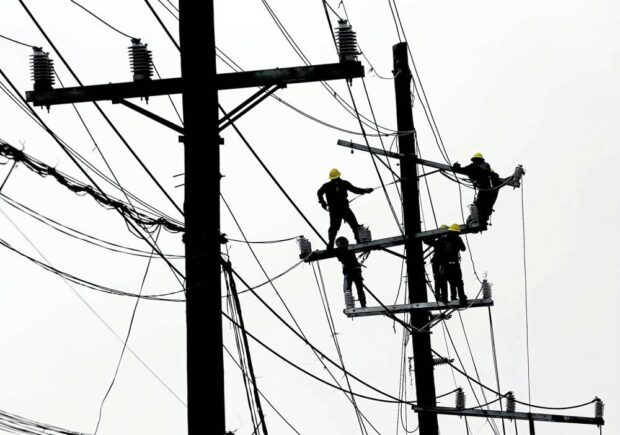
LINE CHECK | Linemen from Meralco conduct maintenance and repair works in Manila in this February 2020 photo. Consumers may see an increase in their electric bills soon as power distributors in Luzon start seeking rate adjustments. (File photo by MARIANNE BERMUDEZ / Philippine Daily Inquirer)
MANILA, Philippines — Consumers in Luzon should brace for higher electricity rates as power distributors on the main island, including Manila Electric Co. (Meralco), start seeking adjustments in their rates.
In a statement on Tuesday, the Energy Regulatory Commission (ERC) said 48 distribution utilities (DUs) have filed for automatic cost adjustment and true-up (the difference between the estimated price when a power supply contract was signed and the actual price when the electricity was used) recoveries for the period 2020-2022, while 20 others are yet to lodge their applications.
Meralco is seeking the ERC’s approval to collect P7.9 billion in under-recoveries which, if approved, would entail collecting about 22 centavos per kilowatt-hour over a 12-month period.
Of the amount, generation charges accounted for P6.4 billion, with the balance related to transmission and systems loss as well as real property taxes.
“The applications will be evaluated by the ERC to validate the recovery of pass-through costs implemented by the DUs and confirm the true-up of other pass-through charges, if any,” the ERC said in a statement on Tuesday.
According to the regulator, this mechanism governs the automatic charging of “pass through” costs to customers of power distributors as part of government efforts to ensure that electricity rates are “fair and reasonable.”
The regulatory agency reminded 20 DUs of their failure to submit the mandated application on time. The agency already extended the deadline for Luzon-based DUs to file for 60 days or until May 30 this year.
The DUs are:
- Abra Electric Cooperative Inc.
- Albay Electric Cooperative Inc.
- First Bay Power Corp.
- First Laguna Electric Cooperative Inc.
- Ibaan Electric Corp.
- Ilocos Norte Electric Cooperative Inc.
- Isabela I Electric Cooperative Inc.
- Isabela II Electric Cooperative
- Kalinga-Apayao Electric Cooperative Inc.
- Masbate Electric Cooperative Inc.
- Nueva Ecija I Electric Cooperative Inc.
- Nueva Vizcaya Electric Cooperative Inc.
- Oriental Mindoro Electric Cooperative Inc.
- Pangasinan I Electric Cooperative Inc.
- Pampanga II Electric Cooperative Inc.
- Quirino Electric Cooperative Inc.
- San Fernando Electric Light & Power Co. Inc.
- Ticao Island Electric Cooperative Inc.
- Zambales I Electric Cooperative Inc.
- Zambales II Electric Cooperative Inc.
“The ERC underscores that DUs’ failure to fulfill these requirements within the designated period may result in suspension of (their) authority to impose pass-through charges to consumers,” it added.
Components
Pass-through charges, according to the regulator, refer to the amount collected from electricity end-users other than the distribution charge, which is the fee for using the facilities that deliver electricity to consumers, whether households or commercial enterprises.
One of these is the generation charge, or the payment for the supply of electricity, which accounts for more than half of the overall rates, and the rates charged by distributors vary sharply.
For example, the effective rate of Meralco, the country’s biggest power distributor, amounted to P8.9918 per kWh in November last year, which was way lower than the P21.9193 imposed by the Pampanga Rural Electric Service Cooperative Inc. in the same period.
‘Fair and reasonable’
Other types of pass-through charges are transmission charge (payment for the use of high voltage transmission lines of the National Grid Corporation of the Philippines) and other subsidies and mandatory payments, such as lifeline and senior citizen subsidies and systems loss (cost-recovery of power lost during the delivery of electricity).
The ERC earlier revised the rules governing the charging of pass-through costs to customers of DUs to ensure “fair and reasonable” power rates.
Resolution No. 14, Series of 2022, titled “A Resolution Adopting the Revised Rules Governing the Automatic Cost Adjustment and True-Up Mechanisms and Corresponding Confirmation Process for Distribution Utilities,” was issued in December last year to push for a more transparent collection of pass-through charges.
ERC Chair Monalisa Dimalanta said then that the amended policy sought “to verify more frequently if the pass-through charges are correct, and in case of over-recovery, immediately refund amounts.”
It updated the framework on the recovery of costs by promoting transparency in prescribing a detailed calculation of the different components of the power bill, setting a limit that prompts an adjustment to correct over- or under-recovery, and streamlining and reducing regulatory lag for a more efficient rate review.

